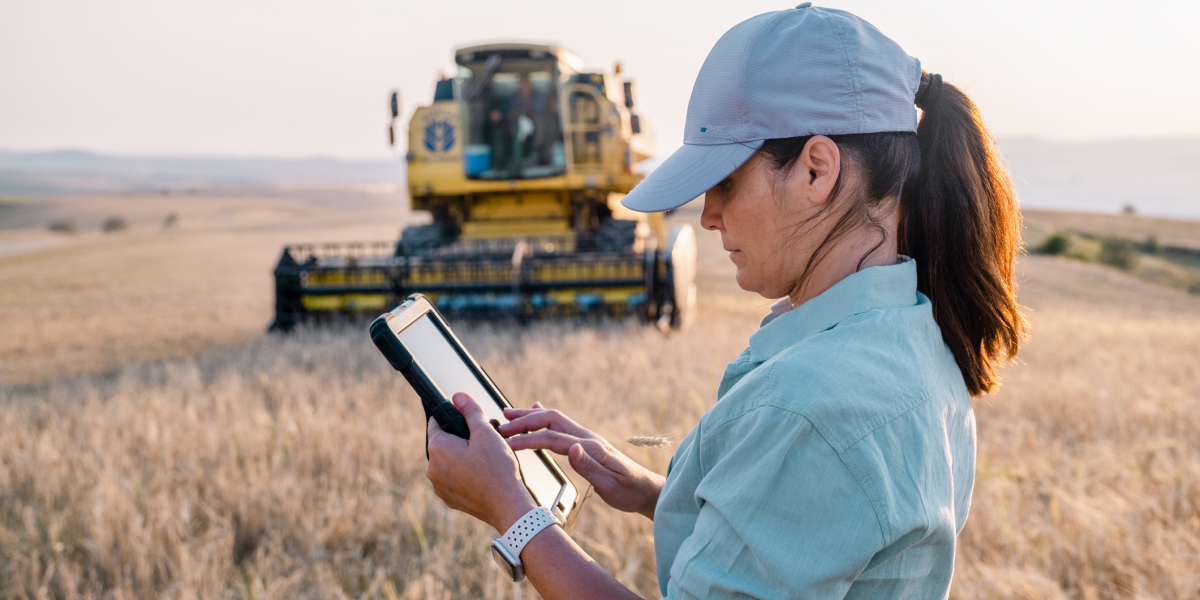
November 27, 2023
By Olivia Richardson and Ryan Tougas-Cooke
Canada’s farmlands could be a massive carbon sink, sequestering atmospheric carbon dioxide, if we can adopt the tools to ensure their success. Amidst concerns over climate change’s growing impact, a landmark report from Nature United highlights the potential of agricultural landscapes to sequester and mitigate over 36 Mt of carbon dioxide emissions annually by 2030. This opens new avenues for carbon markets and nature-based investments that can support farmers as they continue to play a role as vital stewards of Canada’s agricultural landscapes. But how do we measure, report, and verify the diversity of socio-economic and environmental benefits derived from transforming agricultural landscapes? The answer is with innovations in digital agriculture.
Digital agriculture, also called precision agriculture or smart farming, refers to the vast application of digital technologies in farming operations, such as drones, sensors, remote sensing, GPS guidance, farm management software, gene-editing, blockchain, and so on. These technologies rely on the collection and analysis of vast amounts of data to generate models and recommendations to support a variety of decision-makers. For instance, sensors on machinery can generate soil, crop, and input maps, helping farmers make decisions to boost their soil health and increase crop production. The uptake of digital agriculture on farms has rapidly increased over recent decades, ushering in a new era of agriculture characterized by precise applications and data-driven decisions.
The ecosystem services provided by sustainably managed Canadian farmland present a significant opportunity for Canada’s farmers to access new revenue streams, like carbon markets. These types of markets are designed to compensate farmers for the positive environmental outcomes generated on their farms such as increased water and air quality, enhanced biodiversity and reduced emissions. Digital agriculture is key to realizing this goal, as it provides farmers with the data they need to measure, report, and verify changes in on-farm GHG emissions, soil health, and the overall productivity of agricultural ecosystems.
Companies are already exploring how to measure carbon storage on farmland using remote sensing and algorithms, while others are using on-farm soil sensors to provide real-time metrics on soil composition, pH, and moisture, informing the overall health of agricultural soils. Farm management software, such as Farmbrite, Agrible, myJohnDeere and Climate Fieldview, are also valuable sources of information that give farmers a holistic overview of their operations and can record the adoption and impact of beneficial management practices, such as cover-cropping and reduced-tillage. Digital agriculture will be vital in scaling-up Canadian carbon markets in the agricultural field and providing farmers and carbon regulators with accurate, actionable data.
Though digital agriculture is vital to the success of carbon and ecosystem service markets, adoption of the most critical technologies across Canada is lagging. While some technologies such as GPS autosteer on farm machinery and farm management platforms are common on Canadian farms, others such as field and soil sensors and nutrient mapping have yet to be widely adopted. One of the main barriers to adopting digital agriculture is the cost of the technology, data storage, software and analytics. Producers may be required to pay additional fees or monthly subscriptions for these services, raising concerns of the net benefits these technologies provide to farmers.
Another significant barrier is the lack of training and support available to farmers on how to effectively use and repair new technologies for their specific needs. Data privacy, ownership and broader issues surrounding data governance and interoperability are also significant concerns for farmers and advocates. Building trust through the data collection process could also help reduce barriers to adoption. In the absence of a national strategy to govern the collection and use of farm data, technology providers have been left to create their own data management standards. This dynamic increases the costs of doing business for technology providers, in addition to creating barriers for achieving interoperability.
Digital agriculture provides numerous benefits and can help farmers access carbon and ecosystem service markets. However, a variety of barriers to adoption must be addressed to catalyze widespread use on Canadian farms. Three key areas of action can provide the necessary support farmers need to increasingly adopt digital agriculture tools in Canada:
1) Investing in farmer-led communities of practice. Facilitating peer groups, support networks and additional training opportunities to enhance education and knowledge transfer about digital agriculture.
2) Engaging farmers in co-creating digital agriculture products, including updates to the user interface, to ensure that products are user-friendly, applicable to various farm types and help farmers meet their operational and environmental goals.
3) Expanding funding opportunities to facilitate adoption. Innovative funding opportunities, such as grants, cost shares, or tax breaks that target the adoption of new technologies are needed. Reducing financial barriers to adoption will be crucial for ensuring farmers are equipped with the right information to make holistic management decisions.
Digital agriculture technologies are a catalytic opportunity for Canada’s agriculture sector. Success of this opportunity hinges on identifying the most cost-effective pathways and innovative policy solutions to support farmer adoption. These broad policy suggestions mirror demands for investments in data transparency, education, and design, such as the Green Budget Coalition’s recommendations for 2024. As carbon and ecosystem service markets develop in Canada, digital agriculture will continue to play a key role in supporting the decision-making capacity of farmers. We look forward to continuing to engage with Canada’s agriculture and agri-food sector to support these outcomes.